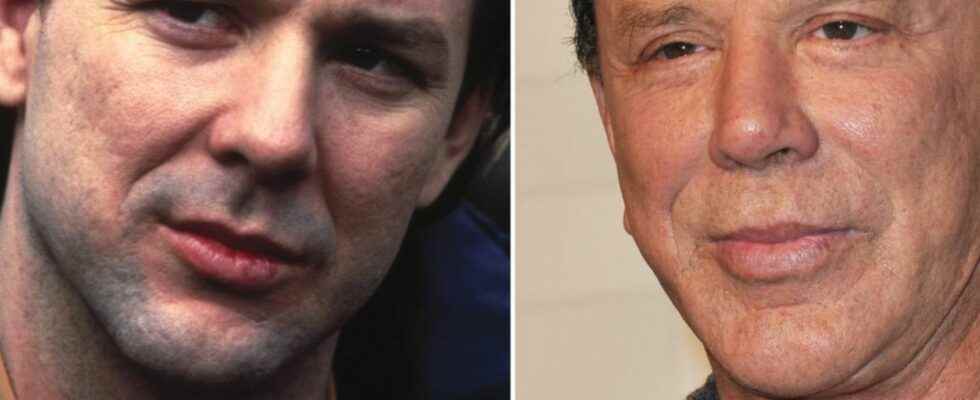Mickey Rourke turns 70
1980s superstar
Mickey Rourke in ‘The Godfather of Greenwich Village’ in 1984 (left) and in 2010 in Los Angeles, California.
© imago images/EntertainmentPictures/Featureflash Photo Agency/Shutterstock.com
He was one of the superstars of the 1980s but later destroyed his face in the boxing ring. Mickey Rourke turns 70 today.
The US actor Mickey Rourke (70) caused a stir just a few months ago, when he was a guest on the talk show Piers Morgan Uncensored. There he pulled over his colleague, Hollywood star Tom Cruise (60). In his world, Rourke said, Cruise is “meaningless” because he’s been “playing the same damn role for 35 years.” Instead, he respects the work of actors like Christopher Walken (79), the early Robert De Niro (79) or Marlon Brando (1924-2004). “That’s the kind of actor I want to be,” Rourke said.
Mickey Rourke really doesn’t have to be accused of always playing the same role. Rather, his filmography spanning five decades has a number of highlights, breaks, an almost lost decade in the 1990s and later a great comeback with the drama “The Wrestler”.
The bad boy was an icon of the 1980s
The actors and role models mentioned at the beginning, such as Marlon Brando and Robert De Niro, were probably not chosen by chance. Like Rourke, they learned their trade at the famous Actors Studio in New York, the cradle of so-called method acting. After Rourke had studied the formative acting methods of the second half of the 20th century there, he was drawn to Hollywood in his mid-twenties.
Success came quickly there. His supporting role in the neo-noir thriller “Body Heat” (German title: “Heiss-Blood – Cold-Blood”, 1981) already caused a stir. He then starred in Francis Ford Coppola’s (83) “Rumble Fish” and was considered one of the greatest talents of his generation from then on. Director Barry Levinson (80) attested to Rourke at that time an impressive mixture of “hardness and vulnerability”.
The mid-1980s then belonged entirely to mimes. The hard cop thriller “In the Year of the Dragon” (1985) by Michael Cimino (1939-2016) and the erotic film classic “9 1/2 Weeks” (1986) with Kim Basinger (68), who, by the way, is said to have once said about kissing scenes with her film partnersthat his mouth tasted like an ashtray. The occult thriller “Angel Heart” (1987) in particular is still convincing today with its shimmering, gloomy southern atmosphere, a breathtaking twist at the end and Mickey Rourke at the peak of his creative powers.
Mickey Rourke destroys his face – and his career
Like so many Hollywood stars before him, fame went to Mickey Rourke’s head. “I was out of control and didn’t think the party was going to stop” he looked back at that time. Towards the end of the 1980s he “lost everything: my house, my career, my wife. My life was a disaster area”.
Dustin Hoffman (85) called him about a role in his film “Rain Man” at the time, but Rourke didn’t even call back. Legendary director Quentin Tarantino (59) also got in touch and offered him the role later played by Bruce Willis (67) in “Pulp Fiction” (1994). He didn’t read the screenplay for the cult film of the early 1990s at all.
In addition to parties and bad role decisions, his acting career was not helped by the fact that Rourke destroyed his face beyond recognition in eight professional boxing matches. According to his own statement, he broke his nose twice and a cheekbone in the ring. He tried to “makeshift repairs” to the resulting “chaos” with a total of six cosmetic surgeries, but ended up with a bad surgeon.
His world-famous face, an actor’s most important asset, was lost forever.
“Sin City” and “The Wrestler”: Mickey Rourke fights back
After the self-destructive 1990s, Rourke really caught his eye again in the weird comic adaptation “Sin City” (2005) by Frank Miller (65) and Robert Rodriguez (54), before filmmaker Darren Aronofsky (53) gave him the gave worn-out wrestler Randy “The Ram” Robinson the most significant role of the second half of his career in the drama “The Wrestler” (2009). Film journalists and critics repeatedly point out parallels between Rourke’s biography and that of his character, who also had their peak in the 1980s. The very real injuries that Rourke sustained in the boxing ring also seem to be reflected in the character Randy “The Ram”.
Nominated for an Oscar, he received a Golden Globe for “Best Actor” for “The Wrestler” – and was suddenly back in fashion in Hollywood. Engagements in Sylvester Stallone’s (76) old men’s fun “The Expendables” (2010) and the Marvel blockbuster “Iron Man 2” (2010) followed. Yet Marvel Studios blamed Rourkefor cutting the nuances of his portrayal out of the film. Marvel only wanted a “one-dimensional villain”.
His impressive comeback was short-lived afterwards. Over the past several years, Rourke has appeared in what feels like an endless stream of B, C, and D action films that almost go unnoticed. He now speaks openly about the abusewhich he suffered as a teenager at the hands of his stepfather, who was a police officer. This made him hard – and led to lifelong problems with authority figures, including film directors.
In the near future, viewers will be able to see Rourke in a slightly larger role. In the ensemble film “The Palace” by Roman Polanski (89), he appears alongside Fanny Ardant (73), John Cleese (82) and the German actor Oliver Masucci (53). The film is scheduled to be released in cinemas at the turn of the year.
